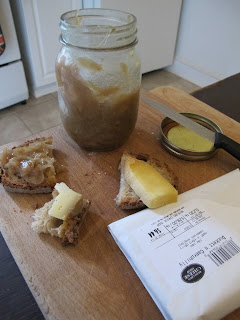Straight after posting about the frozen cream, I walked into the kitchen and made these bad boys.
It took 30 minutes and we ate them straight with maple syrup from our trip to Vermont. And so, I must make a confession.It is my intention with this blog that I will not just do a cut and paste job of other people's hard work in writing recipes. My intention is that I will adapt them in some way, either through my own cack-handedness of forgetting to buy something or by thinking 'I don't think that is necessary', trying out that thought and passing on to you the results.
In this case however, the recipe was so fantastic (literally stripped down to its core components and ready to go) that I have added nothing to it. So I must begin this post by saying that this is all someone else's hard work. I even thought twice about posting it as I didn't think it was fair to grab anyone else's limelight but I felt that if I posted about it in the vein of 'this is a foolproof, gold star recipe of xxxx person' then it was ok.
Here is the recipe, which I came across via Joanna Goddard's eclectic and extremely friendly blog Cup of Jo
As I say, I did nothing but followed it and it was great. I had everything already in the house apart from the buttermilk so it really is a great recipe in that it needs so little prep.
My husband commented on the lightness of the pancakes and I think it is due to the recipe's insistence not to overwhisk and to use a fork. A really good bit of advice.
Mix dry ingredients which are 1 cup all-purpose flour, 2 tablespoons sugar, 1 teaspoon baking powder, 1 teaspoon baking soda, ¼ teaspoon kosher salt). I actually forgot the salt and had no baking soda so in the interests of honesty I have not bolded them as I did not use them. But in the interests of not messing around with someone else's great recipe, those are what you should use. But they turned out fine with 3 out of 5.
Mix wet ingredients which are 1 tablespoon unsalted butter, melted and slightly cooled
That poor pan is literally dying before my very eyes.
1 ¼ cup buttermilk, shaken, 1 large egg, ½ teaspoon pure vanilla extract. I managed to include all of these!
Then wet ingredients meet dry ingredients
All some very gentle forking takes place. The recipe states that it should be barely combined, with some lump action taking place. This made me nervous as I have been schooled in the 'no lump' way but in the interestst of actually following the darned recipe, I let those lumps roam free.
As you can see, pan avec melted butter ready to go. I dropped in two tablespoons-worth of batter (I used a metal spoon rather than the 1/4 cup the recipe suggested as the mix looked a bit claggy and I envisaged only 1/8 cup actually ending up in the pan). I didn't touch them, just watched and then bubbles started appearing. Based on my experiences making blinis, it is the bubbles that form where the batter has contact with the pan, basically your pancake perimeter, that indicate that the base is sealed and verging on being ready to flip.
These fellas need longer.
I also need to point out that these are far too big for the pan in terms of effective flipping so one or two got a bit cropped when I flipped them into the side of the pan. But those bits fell off and cooked so I ate them. I have very little patience to cook things one by one and will always try and cram in one more than the recipe says. But in this case, it was ok as we got the pancakes double-quick and I got to eat mini-pancakes as I was frying.
So thank you to the lovely recipe-maker lady and to Jo for posting the recipe in the first place.
It is a good 'un.
















